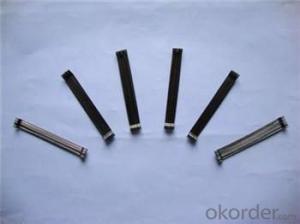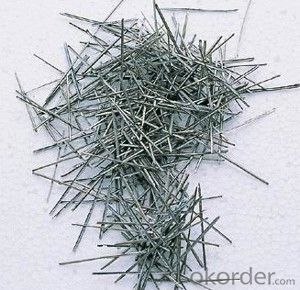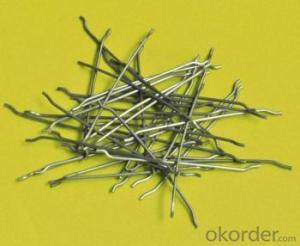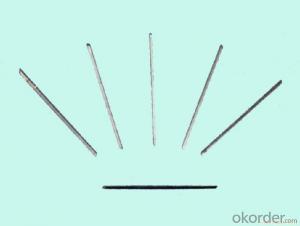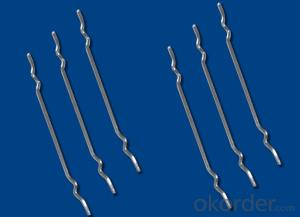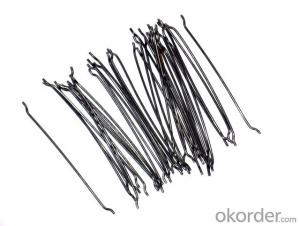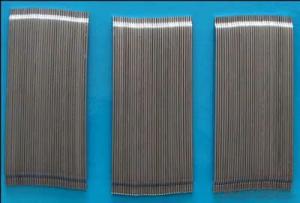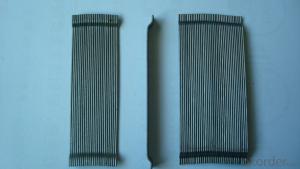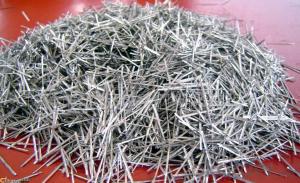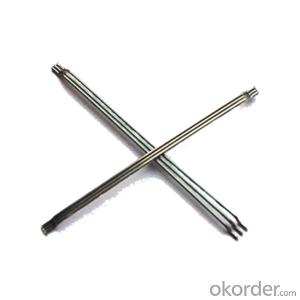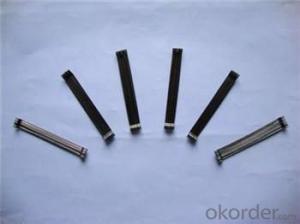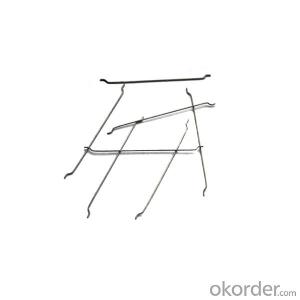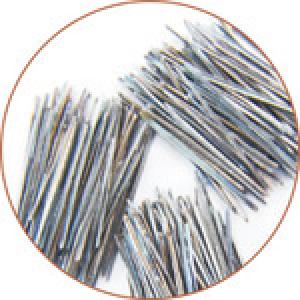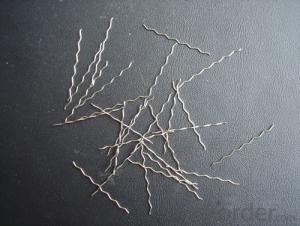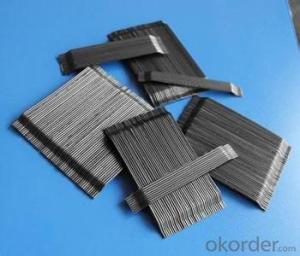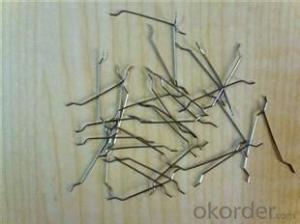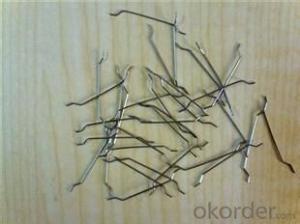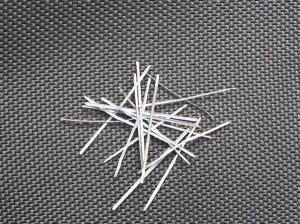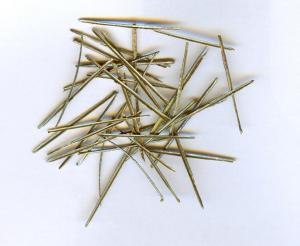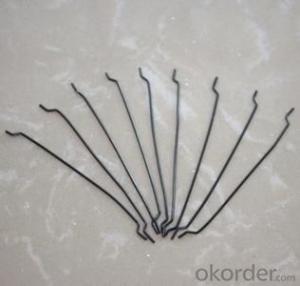Melt Extract Stainless Steel Fiber for Construction Companies UAE High Quality
- Loading Port:
- Tianjin
- Payment Terms:
- TT OR LC
- Min Order Qty:
- 1 m.t.
- Supply Capability:
- 600 m.t./month
OKorder Service Pledge
Quality Product, Order Online Tracking, Timely Delivery
OKorder Financial Service
Credit Rating, Credit Services, Credit Purchasing
You Might Also Like
Quick Details
Place of Origin: Tianjin, China (Mainland)
Model Number: 0.55
Material: Steel
Production Process: Cold drawn
Fiber Lengh: 35
Type: 1
Compressive Strength: >1200MPa
Aspect ratio: 63
Standard: ASTM A820M-11
Section Shape: Circular
Application: Concrete Reinforcement
Product Application: Industrial Floor
Packaging & Delivery
| Packaging Details: | 20 kg/Bag,50 bags/Pallet or 1,000kg/ Bulk Bag |
|---|---|
| Delivery Detail: | 1 Month |
Product Description
| Diameter | 0.55 mm (0.217 in) | ||
| Length | 35 mm (13.780 in) | ||
| Aspect Ratio | 63 | ||
| Tensile strength | 1200 MPa | ||
| Type | Cold drawn Steel Fiber | ||
| End | Hooked-end Steel Fiber | ||
| Glued/Loose | Glued Steel Fiber | ||
| Bending Angle | 45°(min.30°) | ||
| Usage & Performance | Floor:Trafficked areas and Industrial floors | ||
| Shotcrete :Slope stabilization and Final lining | |||
| Precast concrete:Pipe and Railway sleepers | |||
| Packing | Standard Export Pallet Packing | Bag Packing | 20 kg/Bag,50 bags/Pallet |
| Bulk Packing | 1,000kg/ Bulk Bag | ||
| Loading Quantity | 20’GP | 20-25 Tonne/Tonnes | |
| 40’GP | 25-27 Tonne/Tonnes | ||
| 40’HQ | 25-27 Tonne/Tonnes | ||
| MOQ | 1 kg for trial order | ||
| Supply Ability | 10,000 Tonne/Tonnes per Year | ||
| Payment Terms | T/T or L/C at sight | ||
| Delivery Time | Within 15 days after receiving deposit or original L/C at sight | ||
| Certification | ISO9001:2000, CE, | ||
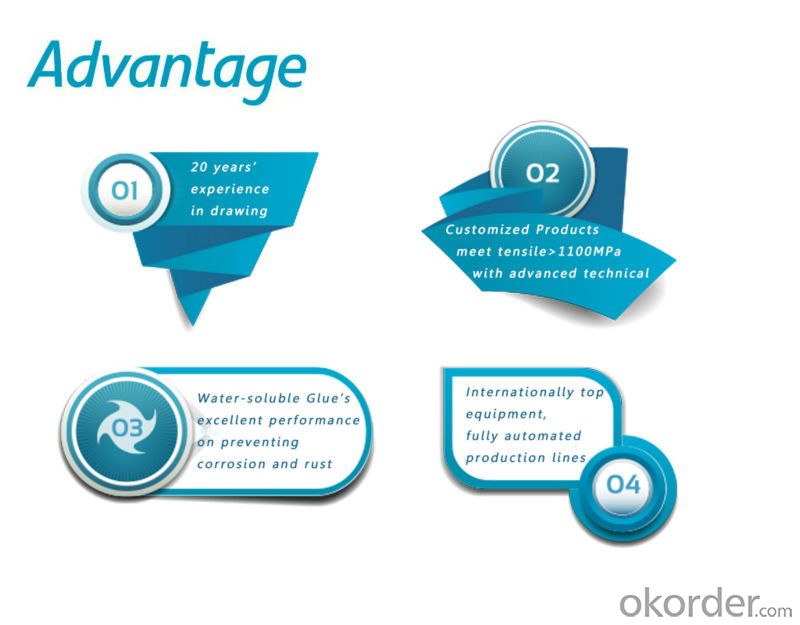
| Product | Diameter | Length mm/in | Aspect Ratio | Type | Packing |
| G-6030 | 0.5 mm (0.197 in) | 30 mm (11.811 in) | 60 | Glued | 20 kg/Bag, or 1,000kg/ Bulk Bag |
| G-6535 | 0.55 mm (0.217 in) | 35 mm (13.780 in) | 65 | Glued | 20 kg/Bag, or 1,000kg/ Bulk Bag |
| G-6035 | 0.6 mm (0.236 in) | 35 mm (13.780 in) | 60 | Glued | 20 kg/Bag, or 1,000kg/ Bulk Bag |
| G-8060 | 0.75 mm (0.295 in) | 60 mm (23.622 in) | 80 | Glued | 20 kg/Bag, 50 bags/Pallet |
| G-6060 | 0.9 mm (0.354 in) | 60 mm (23.622 in) | 60 | Glued | 20 kg/Bag, 50 bags/Pallet |
| G-6030 | 0.5 mm (0.197 in) | 30 mm (11.811 in) | 60 | Loose | 20 kg/Bag, or 1,000kg/ Bulk Bag |
| G-6535 | 0.55 mm (0.217 in) | 35 mm (13.780 in) | 65 | Loose | 20 kg/Bag, or 1,000kg/ Bulk Bag |
| G-6035 | 0.6 mm (0.236 in) | 35 mm (13.780 in) | 60 | Loose | 20 kg/Bag, or 1,000kg/ Bulk Bag |
| G-8060 | 0.75 mm (0.295 in) | 60 mm (23.622 in) | 80 | Loose | 20 kg/Bag, 50 bags/Pallet |
| G-6060 | 0.9 mm (0.354 in) | 60 mm (23.622 in) | 60 | Loose | 20 kg/Bag, 50 bags/Pallet |
- Q: Can melt extract stainless steel fiber be used in pavement rehabilitation applications?
- Yes, melt extract stainless steel fiber can be used in pavement rehabilitation applications. It offers excellent reinforcement and durability properties, enhancing the strength and longevity of the pavement. Additionally, its resistance to corrosion and high temperature make it suitable for such applications.
- Q: Can melt extract stainless steel fiber replace traditional steel reinforcement in concrete?
- Certain applications can see the substitution of traditional steel reinforcement in concrete with melt extract stainless steel fiber. Melt extract stainless steel fiber presents various advantages over traditional steel reinforcement, including increased durability, enhanced crack resistance, and improved corrosion resistance. These fibers, made from stainless steel, are typically incorporated into the concrete mixture during the mixing process. They contribute additional strength and support to the concrete, reducing the reliance on traditional steel reinforcement like rebar or mesh. One of the primary benefits of melt extract stainless steel fiber is its ability to enhance the durability of concrete structures. By evenly distributing stress throughout the concrete, the fibers decrease the likelihood of cracks and improve the overall strength of the structure. This aspect proves especially valuable in applications where the concrete will experience heavy loads or extreme conditions. Another advantage is the improved crack resistance offered by melt extract stainless steel fiber. Acting as reinforcement within the concrete, the fibers inhibit the propagation of cracks and minimize their size. Consequently, this leads to more durable and long-lasting concrete structures. Moreover, melt extract stainless steel fiber provides better resistance to corrosion when compared to traditional steel reinforcement. Stainless steel is renowned for its high level of resistance to corrosion, making it a dependable choice for applications involving exposure to harsh environments or chemicals. Nevertheless, it is crucial to note that melt extract stainless steel fiber may not be suitable for all concrete applications. The decision to replace traditional steel reinforcement with stainless steel fiber should be made based on factors such as specific project requirements, structural design, and the expected loads and conditions the concrete will endure. Consulting with a structural engineer or concrete expert is advised to determine the appropriateness of employing melt extract stainless steel fiber in a particular project.
- Q: What is the effect of melt extract stainless steel fiber on the dimensional stability of concrete?
- The use of melt extract stainless steel fiber in concrete has a significant effect on the dimensional stability of the material. These fibers are added to the concrete mixture during the mixing process, where they are evenly dispersed throughout the mixture. One of the main benefits of melt extract stainless steel fiber is its ability to enhance the overall strength and durability of concrete. The fibers act as reinforcement, providing additional tensile strength to the material. This reinforcement helps to prevent cracking and shrinkage, which are common issues in concrete structures. By reducing cracking and shrinkage, melt extract stainless steel fiber improves the dimensional stability of concrete. This means that the concrete maintains its original shape and size over time, even under varying environmental conditions such as temperature changes or moisture exposure. The addition of these fibers also improves the overall performance of the concrete in terms of resistance to impact, abrasion, and fatigue. This makes it particularly useful in applications where the concrete will be subjected to heavy loads or frequent wear and tear. Furthermore, melt extract stainless steel fiber can also enhance the fire resistance of concrete. The fibers have a high melting point, which helps to slow down the spread of fire and prevent structural collapse. This is especially important in buildings and structures where fire safety is a concern. Overall, the use of melt extract stainless steel fiber in concrete greatly improves its dimensional stability, strength, and durability. This leads to longer-lasting, more reliable concrete structures that are better able to withstand various environmental and mechanical forces.
- Q: Are there any specific curing requirements for concrete with melt extract stainless steel fiber?
- Yes, there are specific curing requirements for concrete with melt extract stainless steel fiber. Firstly, it is important to note that the inclusion of stainless steel fibers in concrete can significantly enhance its mechanical properties, such as tensile strength and resistance to cracking. However, the presence of these fibers can also affect the curing process and require certain considerations. One key requirement is to ensure adequate moisture during the curing process. Concrete with stainless steel fibers should be kept moist to prevent premature drying, as this can lead to shrinkage and cracking. Moist curing methods, such as using wet burlap or plastic sheets, can be employed to retain moisture and promote proper hydration of the concrete. Additionally, temperature control is crucial during the curing period. High temperatures can accelerate the hydration process, leading to increased shrinkage and potential cracking. On the other hand, low temperatures can hinder the curing process and result in reduced strength development. Therefore, maintaining a moderate and consistent temperature is essential for the proper curing of concrete with stainless steel fibers. Furthermore, it is advisable to extend the duration of the curing period for concrete with stainless steel fibers. This is because the fibers may impede the movement of water within the concrete matrix, slowing down the hydration process. By extending the curing time, the concrete has more opportunity to develop its desired strength and durability. Lastly, it is crucial to follow the manufacturer's recommendations regarding curing requirements for concrete with melt extract stainless steel fibers. Different fiber types and manufacturers may have specific guidelines and recommendations for curing, which should be followed to ensure optimal performance of the concrete. In summary, curing requirements for concrete with melt extract stainless steel fibers include maintaining moisture, controlling temperature, extending the curing period, and following manufacturer guidelines. By adhering to these requirements, the concrete can achieve its desired strength and durability while benefiting from the enhanced properties provided by the stainless steel fibers.
- Q: What are the different types of melt extract stainless steel fibers available in the market?
- There are several different types of melt extract stainless steel fibers available in the market. Some of the most common types include: 1. Type 304 Stainless Steel Fibers: These fibers are made from a combination of iron, chromium, and nickel. They offer excellent corrosion resistance and are often used in applications where exposure to chemicals or moisture is a concern. 2. Type 316 Stainless Steel Fibers: These fibers are similar to Type 304, but they contain a higher amount of molybdenum, which provides even greater corrosion resistance. They are often used in more demanding environments, such as marine applications or in areas with high chloride concentrations. 3. Type 430 Stainless Steel Fibers: These fibers contain a higher amount of chromium and are known for their good resistance to oxidation and heat. They are often used in high-temperature applications, such as in furnaces or automotive exhaust systems. 4. Type 410 Stainless Steel Fibers: These fibers contain a higher amount of carbon, which gives them excellent wear resistance. They are often used in applications where abrasion or wear is a concern, such as in concrete reinforcement or in industrial equipment. 5. Type 420 Stainless Steel Fibers: These fibers contain a higher amount of carbon and are often heat treated to increase their hardness. They are commonly used in applications where high strength and wear resistance are required, such as in cutting tools or in high-load bearing structures. It is important to note that the availability of these different types of melt extract stainless steel fibers may vary depending on the supplier and the specific requirements of the application. It is recommended to consult with a knowledgeable supplier or engineer to determine the most suitable type for a particular project.
- Q: How does melt extract stainless steel fiber improve the resistance to spalling in concrete?
- The addition of melt extract stainless steel fibers to concrete enhances its resistance to spalling by reinforcing and increasing its overall durability. These stainless steel fibers disperse evenly throughout the concrete, creating a three-dimensional network that acts as reinforcement. This reinforcement improves the concrete's tensile strength and crack resistance. Spalling, which is the chipping, flaking, or peeling off of the concrete surface, can occur due to freeze-thaw cycles, high temperatures, or chemical exposure. However, the inclusion of melt extract stainless steel fibers helps prevent cracks from spreading and reduces the expansion and contraction of the concrete, mitigating these effects. The high tensile strength of stainless steel fibers allows them to absorb and distribute stress in the concrete, preventing crack formation and minimizing the impact of external forces. Additionally, the corrosion-resistant properties of stainless steel ensure the fibers remain intact and do not deteriorate over time, providing long-term reinforcement. Furthermore, the three-dimensional network formed by the stainless steel fibers helps bridge any cracks that may develop in the concrete. This bridging effect prevents the cracks from widening and propagating, significantly reducing the likelihood of spalling. In conclusion, melt extract stainless steel fiber improves concrete's resistance to spalling by reinforcing the material, increasing its tensile strength, reducing crack propagation, and enhancing its overall durability. By incorporating these fibers into the concrete mix, the risk of spalling due to freeze-thaw cycles, high temperatures, or chemical exposure is greatly minimized, resulting in a more resilient and long-lasting concrete structure.
- Q: Can melt extract stainless steel fiber be used in shotcrete or sprayed concrete?
- Indeed, shotcrete or sprayed concrete can make use of melt extract stainless steel fiber. This form of reinforcement material is incorporated into concrete mixtures to augment their resilience and longevity. Specifically, it proves advantageous in shotcrete or sprayed concrete scenarios where the concrete is sprayed onto a surface, as it heightens the connection between the concrete and the underlying substrate. By incorporating melt extract stainless steel fiber into shotcrete or sprayed concrete, one can effectively avert cracking and enhance the concrete's overall structural soundness.
- Q: How does the addition of melt extract stainless steel fiber affect the workability of concrete?
- By incorporating melt extract stainless steel fiber, the workability of concrete can be significantly affected. These fibers, which are thin strands, are mixed into the concrete during the mixing process. Typically, they are added in small percentages ranging from 0.5% to 2% by volume. When stainless steel fibers are added to concrete, one of the primary outcomes is an enhancement in workability. Workability, in this context, refers to how easily concrete can be mixed, placed, and finished. By improving the cohesiveness and flowability of the concrete mixture, stainless steel fibers make it more manageable and manipulable during construction. These fibers serve as reinforcement agents within the concrete, increasing its resistance to cracking, shrinkage, and deformation. Consequently, the overall strength and durability of the concrete are improved, making it more resilient against external forces and environmental conditions. Furthermore, the addition of stainless steel fibers can also improve the plasticity of the concrete, leading to better compaction and consolidation. As a result, the hardened concrete attains increased density and reduced porosity, thereby enhancing mechanical properties like compressive strength and flexural strength. Nevertheless, it is important to acknowledge that adding stainless steel fibers can also present some challenges to the workability of concrete. The fibers may cause the mixture to become slightly sticky, making it more difficult to handle and place. Additionally, the presence of fibers can increase the viscosity of the concrete, making it harder to pump and transport. In conclusion, by adding melt extract stainless steel fiber to concrete, its workability can be positively influenced through improved cohesiveness, flowability, and plasticity. Nonetheless, careful consideration of dosage and mix design is necessary to ensure that the desired workability is achieved without compromising other concrete properties.
- Q: Can melt extract stainless steel fiber be used in residential driveway pavements?
- Yes, melt extract stainless steel fiber can be used in residential driveway pavements. These fibers provide enhanced strength and durability to the pavement, making it more resistant to cracking and wear. Additionally, the stainless steel material offers excellent corrosion resistance, making it suitable for long-term use in outdoor settings.
- Q: Can melt extract stainless steel fiber be used in high-performance concrete?
- Certainly, high-performance concrete can indeed utilize melt extract stainless steel fiber. Commonly employed as reinforcement, stainless steel fibers enhance the mechanical properties and durability of concrete. These specific fibers are produced by melting stainless steel and then drawing it into fine strands. Generally, a small quantity of these fibers is added to concrete mixes to enhance tensile strength, flexural strength, and resistance to cracking. The utilization of melt extract stainless steel fibers in high-performance concrete can significantly enhance its performance. Functioning as reinforcement, these fibers provide additional strength while impeding crack propagation. This is particularly vital for high-performance concrete, which aims to possess superior mechanical properties and resilience to harsh conditions. The incorporation of melt extract stainless steel fibers can optimize the concrete's ability to withstand impact, fatigue, and fire. It also aids in diminishing shrinkage and cracking, thereby extending the lifespan of concrete structures. Furthermore, stainless steel fibers possess corrosion resistance, which proves highly advantageous in environments where the concrete encounters aggressive chemicals or moisture. In summary, melt extract stainless steel fiber serves as a suitable and effective reinforcement material for high-performance concrete. It elevates the concrete's mechanical properties, durability, and resistance to cracking, subsequently enhancing the overall performance of the concrete structure.
Send your message to us
Melt Extract Stainless Steel Fiber for Construction Companies UAE High Quality
- Loading Port:
- Tianjin
- Payment Terms:
- TT OR LC
- Min Order Qty:
- 1 m.t.
- Supply Capability:
- 600 m.t./month
OKorder Service Pledge
Quality Product, Order Online Tracking, Timely Delivery
OKorder Financial Service
Credit Rating, Credit Services, Credit Purchasing
Similar products
Hot products
Hot Searches
Related keywords
